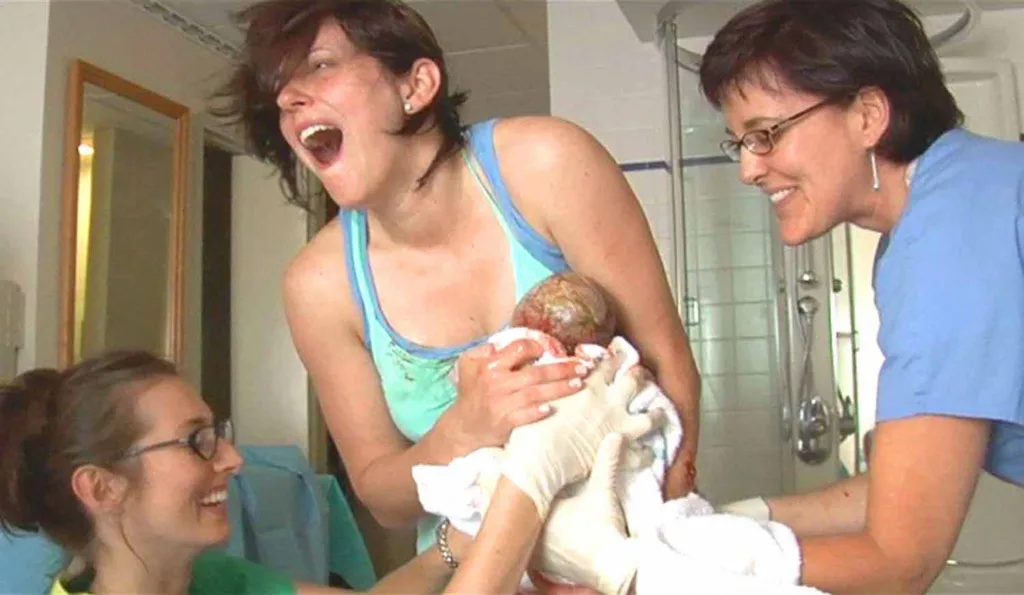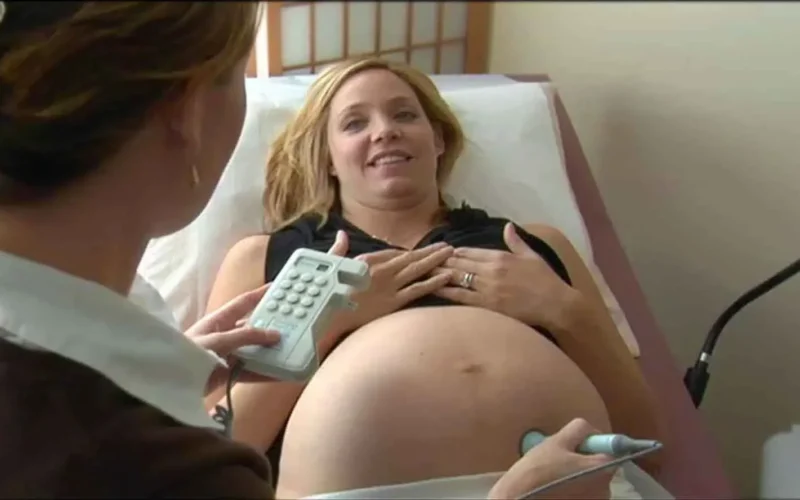I finally watched The Business of Being Born (BoBB) recently, thanks to a free viewing period to celebrate 15 years since the film’s premiere. I’d heard of the documentary multiple times over the last seven or so years. I only knew that it presented a different view of home births than the one I’d heard during nursing school (and from my hospital colleagues). My skepticism manifested as disinterest in watching the film. But two things eventually changed my mind, finally prompting me to give it a chance.
The first was my own negative experience of giving birth in what I’ll call ‘the modern conventional way,’ with an epidural for pain control. A few years later, I gave birth with a shot of pain medicine but no epidural. The second thing was watching BoBB executive producer Ricki Lake and director Abby Epstein’s documentary The Business of Birth Control (BoBC) last year (reviewed for Natural Womanhood, here). I found BoBC compelling and lucid, not hokey and anti-science. So last weekend, I sat down to watch the 85-minute The Business of Being Born. Here’s what I think BoBB got right about birth in the United States, and how it connects to our unacceptably high maternal mortality rates.
The medicalization of birth has led many women to believe they can’t birth without medicine
Early on in BoBB, one of the interviewed women made a statement that really resonated with me. She commented, “Basically what the medical profession has done over the last 40 or 50 years is convince the vast majority of women that they don’t know how to birth.” Yes!
As I grew up, I only heard of women, my mom included, who gave birth with epidurals. The few births I heard of that were unmedicated were “accidentally” so. That is, the baby came before the epidural could be placed. Combined with what I learned in nursing school, I, along with many of my peers, believed that epidurals were a necessity for giving birth. In other words, I couldn’t give birth without one.
Why are American women so afraid of giving birth?
What was I so afraid of? In The Business of Being Born, Anna Verwaal, nurse and doula, opined, “Women [in America] are so afraid because they do not have an image of normal birth. Women in America don’t know what’s normal about birth.” Multiple interviewees pointed out how the portrayal of birth in the media depicts birth as a “scary” and “dangerous” emergency. Doctors typically play a semi-savior role. There’s no mention of the inherent wisdom of laboring women’s bodies. Nor is there understanding that we are physically and emotionally “built to birth.”
In my mid-twenties, I heard of several friends who gave birth unmedicated. One even had a home birth! These women talked very positively about their birth experiences, which were neither painless nor horrifying. Their births were physically intense, profoundly emotionally rich, and deeply fulfilling. But these friends also fell squarely into the stereotypical “crunchy” or “granola” camp, whereas I did not. My open-mindedness to the experiences they shared was often half-hearted.
What did my “crunchy” friends know that I did not? Despite graduating from nursing school, growing up with six siblings, and attending a birth class, I knew nothing of the cardinal movements of labor, the positions the baby has to go through to engage in the pelvic inlet, move through the mid-pelvis and pelvic outlet, and then emerge into the wide, wide world. Because I knew nothing of what a baby’s body does during labor, I had no understanding of how my movement naturally and necessarily facilitated my baby’s movement.
A short history lesson
The Business of Being Born portrayed this lack of knowledge as an unintended consequence of the medicalization of birth. The ‘medicalization of birth’ means the shift away from midwife-led births toward a medical model that emphasized technology. In many ways the medical model still treats pregnancy as an illness in need of medication and intervention. This shift started in the early twentieth century. It began in the United States with an enormously effective smear campaign waged against midwives, especially in the South and East. In an article for Verily, Natural Womanhood’s Cassondra Moriarty provided a concise historical summary of the shift from community-based to hospital-based birth. It can be found here.
But has the medicalization of birth made it safer?
Over and over, BoBB emphasized the ways that the medicalization of birth wasn’t and still isn’t an automatic win for moms and babies. Evidence for this can be seen in our relatively high maternal mortality rate (MMR) in the United States. The MMR is the rate at which women die while pregnant or within one year after giving birth. Here, our MMR is significantly higher than in many other highly developed countries.
Commentaries on national maternal mortality statistics like this one argue that the MMR didn’t change measurably between 2002 and 2018. They claim that the MMR only seemed to increase during that time frame due to improved reporting. But the preventability of maternal mortality is largely agreed upon. Just three years ago, a Natural Womanhood article on maternal mortality cited a statistic that up to 60% of maternal deaths were preventable. According to the latest numbers from the Centers for Disease Control and Prevention (CDC), 80% are now considered preventable.

Change hasn’t always meant progress when it comes to obstetrics care
Would it be a vast oversimplification to say that the medicalization of birth is to blame for our abysmal statistics? Sure. But Dr. Marsden Wagner, former director of Women’s and Children’s Health for the World Health Organization, pointed out multiple ways that medicalization has certainly not helped women over the years. He cited the horrific “twilight sleep” phenomenon of the 1920s and the routine pelvic X-rays on pregnant women in the 1930s that were later discovered to cause cancer. In the 1940s, countless women received the anti-nausea medication thalidomide, which caused birth defects. In the 1990s, women were given Cytotec to induce labor. But this drug, particularly when given to women with previous Cesarean section(s), led to “hundreds of ruptured uteruses and dead babies.”
Even continuous electronic fetal monitoring (EFM), which was introduced in the 1970s and remains standard practice for every laboring woman in most American hospitals, is now only recommended by the American College of Obstetricians and Gynecologists (ACOG) for high-risk women. Low-risk women are only recommended to have periodic auscultation, or checking of the baby’s heart rate with a handheld Doppler. This is because there is “evidence that the use of EFM increases the rate of cesarean deliveries and operative vaginal deliveries.” Indeed, Dr. Marsden observed that within a decade of the introduction of EFM, the Cesarean section rate jumped from 4% to 23% nationally.
What can be done to improve birth outcomes?
The vast majority of births, including low-risk births, are no longer attended by midwives, who are experts in normal, physiologic birth. BoBB quoted the legendary Ina May Gaskin, the “mother of authentic midwifery,” saying “we’re a century or so removed” from birth “going into the hospital,” and “we’re the one [highly developed] country where when birth went into the hospital, the midwives didn’t go with it.” In fact, until the 1950s and the rise of the certified nurse-midwife role, midwives were effectively banned in most of the U.S.
The Business of Being Born interviewees consistently pointed out the difference between a midwifery-centered model of care and a medical model of care overseen by obstetrician-gynecologists (OB/GYNs). Of note, the midwifery-centered model of care included midwifery care provided in hospitals. Certified nurse midwife Caroyln Havens Neimann pointed out, “An obstetrician is a trained surgeon, and (is) usually very, very good at what he or she does.” Elan Vital McAllister, then-president of Choices in Childbirth believed midwives should be the primary managers of all low-risk births. She insisted “They [OB/GYNs] should be doing surgery all day every day, when it’s needed. They should not be doing normal births, because they’re not trained in it. They have no idea how to do it.”
One big difference between the U.S. and other countries with lower maternal mortality rates
Dr. Wagner further stressed that “Everywhere else in the world, that’s what they do [midwifery care for low-risk birth]. You can go to Great Britain, you can go to France, Scandinavia, New Zealand, Germany, Japan—go to all the highly developed places in the world, where they are losing fewer women and fewer babies around the time of birth. And what do you see? You see midwives attending 70 or 80% of births, and the doctors are there to take care of the small percent that develop the complications. That is the proven system everywhere in the world, and the United States stands alone [in not broadly utilizing midwifery care].”
Where you give birth may matter less than who helps you give birth
Notably, hospital births, rather than home births or birth center births, represent the majority of births in many of these highly developed countries, just as they do in the U.S. But for other countries, the role of midwives as well as the approach to birth as normal and natural vs. as an illness in need of medical management–even within a hospital setting–sets them above the United States in terms of better outcomes for moms and babies.
How much difference might a midwifery model of care make for maternal mortality rates and infant health outcomes?
A recent editorial for The Commonwealth Fund by P Mimi Niles, a Certified Nurse Midwife and Assistant Professor at New York University’s Rory Meyers College of Nursing, sought to answer this very question. She wrote, “Research consistently demonstrates that when midwives play a central role in the provision of maternal care, patients are more satisfied, clinical outcomes for parents and infants improve, and costs decrease. Use of midwives is also associated with fewer cesarean sections, lower preterm birth rates, lower episiotomy rates, higher breastfeeding rates, and a greater sense of respect and autonomy for the patient.”
Niles quantified some of the expected benefits of midwifery case based on a recent analysis by the World Health Organization. It suggested that “a midwife workforce, integrated into health care delivery systems, could provide 80 percent of essential maternal care around the world and potentially avert 41 percent of maternal deaths, 39 percent of neonatal deaths, and 26 percent of stillbirths.”
In her Verily article, Cassondra Moriarty shared the results of a five-year, multi-site, federally-funded maternal and infant health initiative. It found that women who gave birth in birth centers under the care of midwives “had babies who were 26 percent less likely to be born preterm. The mothers themselves had a 40 percent lower cesarean rate, were twice as likely to have a successful vaginal birth after Cesarean (VBAC), and had 21 percent lower childbirth costs.”
The most unexpected theme in The Business of Being Born
The single most unexpected theme of BoBB was this: there’s something utterly transformative for women about natural, unmedicated childbirth. In the film, Ricki Lake herself said she’s the type of person who wants pain to be numbed, because “I don’t want to feel a headache.” She went on, “But when it came to birth, it wasn’t an illness. It wasn’t something that needed to be numbed. It was an experience.” Medical anthropologist Robbie Davis-Floyd, PhD, shared “You get the highest oxytocin rush you’ll ever have in your life when you give birth naturally. You will go into an altered state of consciousness and be in a kind of a state of ‘yes, there’s bliss, and yes, there’s pain, and it’s all tied up together’ and you cannot have the bliss without the pain. And it’s the intangible essence of that that we have so much trouble conveying to women.”
Dr. Louann Brizendine, author of The Female Brain, said of the hormones that are believed to launch labor, “[It] Seems like oxytocin starts ‘squirting out’ and triggers labor contractions. That’s when the switch to the maternal circuits, the mommy brain, gets turned on. The whole brain cocktail of hormones and neurochemicals has, for millions of years, been developed to keep the mommy absolutely riveted on protection of the helpless infant.”
Pitocin vs. oxytocin
Brizendine added that, as Natural Womanhood previously covered, “Pitocin doesn’t act like natural oxytocin would in the brain.” This also means a Pitocin-induced birth, and/or one impacted by an epidural or other pain medicine, won’t likely lead to the same hormonal rush as unmedicated vaginal birth. What might this mean for mothers in terms of bonding with their babies, and/or their mental health, either in the immediate postpartum period or long-term? We don’t know.
My experience of the hormonal difference between medicated and unmedicated birth
Truthfully, if I hadn’t experienced the reality of what Ricki and Robbie and Louann described for myself, I doubt I would have believed it just from hearing it in The Business of Being Born. But for my third birth, I didn’t receive any pain medicine at all. By the time I asked for it, I was told it was too late, meaning too close to the birth. So I used nitrous oxide for the pain and anxiety I felt during transition and a very short pushing phase. And after my son was born, I felt the rush.
It is hard to describe, especially because every birth, every last one, is a rush and incredible and miraculous. But something about this one was different, like Robbie said above. With my second birth, I had a medically necessary induction with Pitocin so my newborn could have surgery at two days old. I skipped the epidural but received IV pain medication. Unfortunately, the medicine made me too sleepy to care much afterwards. With my third birth, on the other hand, I was completely present to the entire experience. I felt everything…yes, everything. And that really was important after all.
The bottom line about The Business of Being Born
The Business of Being Born meant many things to many people over the years, especially given that at the time of its release, in Ricki Lake’s words, most people didn’t even know what a doula was. In some ways, times have changed. Doulas, for instance, are now often accepted, even welcomed, by mainstream medical providers.
But three key themes BoBB brought to the fore remain pressing issues today. First, the vast majority of American women believe themselves incapable of giving birth naturally. Isn’t that the opposite of female empowerment? Secondly, the medicalization of birth has not been a panacea for maternal or infant health. Is it time for a return to midwife-led care for low-risk pregnancies? And thirdly, there just might be something extraordinarily powerful for women about unmedicated birth, something that’s a feature—not a bug—of the system.
Natural Womanhood will continue to facilitate these types of important conversations about the strength and innate wisdom of the design of the female body, whether regarding female fertility, pregnancy, postpartum, menopause, or any time in between.
Additional Reading:
Addressing our maternal mortality crisis with fertility awareness
Beyond the epidural: labor pain management options
So you’re going to give birth in the United States…what are your options?









Another type of woman besides the ones in the “crunchy and granola” camps are those who are traditional religiously conservative.